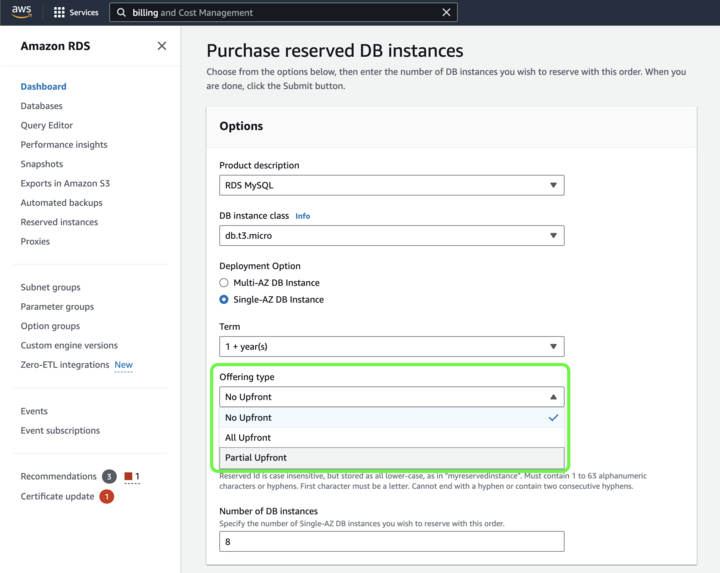In today’s fast-paced digital era, businesses rely heavily on cloud computing services to manage their operations efficiently. When it comes to cloud computing, one of the key decisions involves choosing the right instance purchasing options. With various options available, it can be overwhelming to determine the most suitable approach. In this article, we will focus on Reserved Instance purchasing options, payment terms, and significance for business. By the end, you’ll have a clear understanding of which option aligns best with your payment terms.
Reserved Instances
Reserved Instances provide a significant cost advantage for applications with steady-state or predictable usage patterns. By committing to a one- or three-year term, you can receive a substantial discount on the hourly rate. This option ensures a capacity reservation, guaranteeing that the required resources will always be available. Reserved Instances are suitable for applications with stable workloads that run continuously or for businesses with long-term projects. This allows businesses to save money in the long run by committing to a specific instance type and region.

We will discuss the different payment terms for reserved instances, namely All Upfront, Partial Upfront, and No Upfront. We will explore the benefits and considerations of each option, along with an example to illustrate their usage.
All Upfront Payment
With the All Upfront payment term, organizations pay the entire cost of the reserved instance upfront. This payment option offers the highest level of cost savings over the long term. By making a significant upfront payment, businesses can secure a substantial discount on the hourly rate of the reserved instance. This option is ideal for organizations with predictable workloads and long-term projects.
Let’s say a company needs to run a specific application continuously for three years. By opting for the All Upfront payment term, they pay the total cost of the reserved instance at the beginning of the term. For instance, if the standard On-Demand rate is $0.10 per hour, they might receive a discount of 40% with the All Upfront payment option. This means they would pay $0.06 per hour for the entire three-year period, resulting in significant cost savings
Partial Upfront Payment
The Partial Upfront payment term requires organizations to make a partial upfront payment for the reserved instance, with the remaining balance in regular installments over the reservation term. This payment option offers a balance between upfront cost savings and ongoing payment flexibility. It is suitable for organizations that have some upfront capital available but also prefer to spread out their payments.
Consider a scenario where a company wants to reserve instances for a three-year term. With the Partial Upfront payment option, they might make a 50% upfront payment of the total reserved instance cost. The remaining 50% would be paid as an hourly fee over the term. This payment structure allows organizations to secure cost savings while still having some financial flexibility.
No Upfront Payment
The No Upfront payment term requires organizations to pay the entire cost of the reserved instance as an hourly fee over the term, without any upfront payment. While this option does not provide the same level of cost savings as the upfront payment terms, it offers flexibility for organizations with limited upfront capital or uncertain workloads.
Let’s say there’s a software development company. They have a project that has a one-year duration. However, the company is operating on a limited budget and prefers not to make a large upfront payment for virtual machine instances. With No Upfront payment, they can reserve the required virtual machine instances for the entire one-year term without making any upfront payment. Instead, they will be billed on an hourly basis. This allows them to manage expenses effectively and allocate their budget accordingly. By selecting this option, the company can still benefit from reserved instances, ensuring availability and capacity for their workload without a significant upfront investment.
Conclusion
To summarize, we have learned that Reserved instances are available for a one- or three-year term and provide businesses with cost savings based on the upfront payment made. Furthermore, the three payment terms for Reserved Instances are All Upfront, Partial Upfront, and No Upfront, as discussed earlier.
All Upfront provides the maximum cost savings but requires a large upfront payment. Partial Upfront allows businesses to make a partial upfront payment and pay the remaining balance monthly. No Upfront option doesn’t require an upfront payment but comes with a higher monthly fee. These payment options allow businesses to choose the most suitable payment structure based on their financial capabilities, cash flow, and long-term usage cloud computing needs.
It is essential to analyze the specific needs of your organization and choose the instance and payment option that aligns best with your goals. With the right choice, businesses can achieve cost-effectiveness, scalability, and flexibility in managing their cloud resources, ultimately driving success in the digital era.
